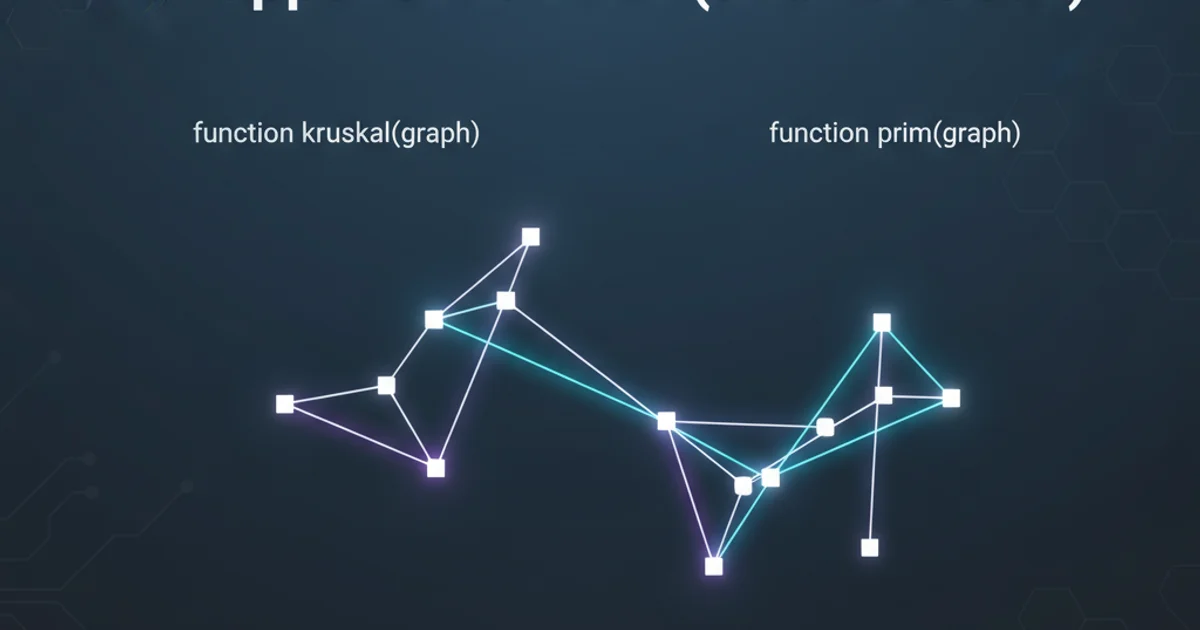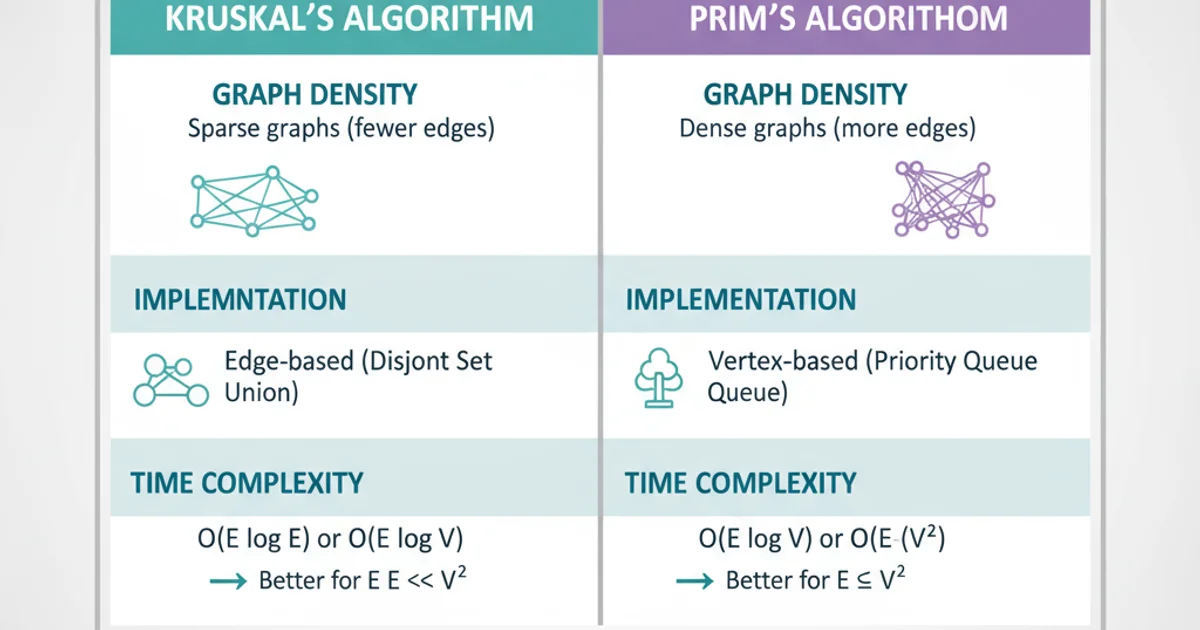When should I use Kruskal as opposed to Prim (and vice versa)?
Categories:
Kruskal vs. Prim: Choosing the Right Minimum Spanning Tree Algorithm

Explore the key differences between Kruskal's and Prim's algorithms for finding Minimum Spanning Trees (MSTs), and learn when to apply each for optimal performance.
Minimum Spanning Tree (MST) algorithms are fundamental in graph theory, used to find a subset of the edges of a connected, edge-weighted undirected graph that connects all the vertices together, without any cycles and with the minimum possible total edge weight. Two of the most prominent algorithms for this task are Kruskal's Algorithm and Prim's Algorithm. While both achieve the same goal, their underlying strategies and performance characteristics differ significantly, making each more suitable for specific scenarios.
Understanding Minimum Spanning Trees (MST)
Before diving into the algorithms, let's briefly recap what an MST is. Imagine a network of cities (vertices) connected by roads (edges), where each road has a cost (weight). An MST would be a selection of roads that connects all cities with the lowest total road cost, ensuring no redundant connections (cycles). MSTs have applications in network design, cluster analysis, and even handwriting recognition.
graph TD
A[Graph] --> B{Connected?}
B -->|Yes| C{Edge-weighted?}
C -->|Yes| D{Undirected?}
D -->|Yes| E[MST Problem]
E --> F{Goal: Connect all vertices}
F --> G{No cycles}
G --> H{Minimum total edge weight}
B -->|No| I[No MST (disconnected)]
C -->|No| J[Not MST Problem]
D -->|No| K[Not MST Problem]Conditions for a Minimum Spanning Tree problem.
Kruskal's Algorithm: The Edge-Centric Approach
Kruskal's algorithm is a greedy algorithm that builds the MST by iteratively adding the cheapest available edge that does not form a cycle with already added edges. It sorts all edges by weight in non-decreasing order and then processes them one by one. A Disjoint Set Union (DSU) data structure is typically used to efficiently detect cycles.
Prim's Algorithm: The Vertex-Centric Approach
Prim's algorithm also follows a greedy strategy but builds the MST by starting from an arbitrary vertex and growing the tree outwards. It maintains a set of vertices already included in the MST and, in each step, adds the cheapest edge that connects a vertex in the MST to a vertex outside the MST. A priority queue is commonly used to efficiently find this cheapest edge.
flowchart LR
subgraph Kruskal's Algorithm
K_Start[Start] --> K_Sort[Sort all edges by weight]
K_Sort --> K_Iterate{For each edge (u,v) in sorted order}
K_Iterate --> K_Cycle{Does (u,v) form a cycle with MST edges?}
K_Cycle -->|No| K_Add[Add (u,v) to MST]
K_Cycle -->|Yes| K_Skip[Skip edge]
K_Add --> K_Iterate
K_Skip --> K_Iterate
K_Iterate --> K_End[End when V-1 edges added]
end
subgraph Prim's Algorithm
P_Start[Start] --> P_Pick[Pick arbitrary start vertex]
P_Pick --> P_Init[Initialize MST with start vertex]
P_Init --> P_Loop{While MST has < V vertices}
P_Loop --> P_Find[Find cheapest edge (u,v) connecting MST to non-MST]
P_Find --> P_Add[Add (u,v) to MST and v to MST vertices]
P_Add --> P_Loop
P_Loop --> P_End[End]
endHigh-level comparison of Kruskal's and Prim's algorithm flows.
When to Use Kruskal's vs. Prim's
The choice between Kruskal's and Prim's algorithm often comes down to the graph's density (number of edges relative to vertices) and the data structures used for implementation.

Key differences and use cases for Kruskal's and Prim's algorithms.
Kruskal's Algorithm is generally better when:
- The graph is sparse: If
E(number of edges) is significantly smaller thanV^2(number of vertices squared), sorting edges is relatively fast. Its time complexity isO(E log E)orO(E log V)with a good DSU, which is efficient for sparse graphs. - You need to process edges globally: Kruskal's considers all edges from the start, making it suitable for scenarios where you might want to filter or pre-process edges based on weight.
- Implementation simplicity (conceptual): While DSU can be tricky, the core idea of sorting edges and adding them if they don't form a cycle is intuitive.
Prim's Algorithm is generally better when:
- The graph is dense: If
Eis close toV^2, Prim's algorithm with a Fibonacci heap can achieveO(E + V log V). With a binary heap, it'sO(E log V). For dense graphs,E log Vis often better thanE log E(sinceEis large,log Eis larger thanlog V). - You need to build the MST from a specific starting point: Prim's algorithm naturally grows the MST from a chosen source vertex.
- The graph is represented by an adjacency matrix: In this case, finding the minimum edge from the current MST to an outside vertex can be done efficiently by scanning rows/columns, leading to
O(V^2)complexity, which is good for dense graphs.
Example Implementations (Pseudocode)
To illustrate the core logic, here's a simplified pseudocode for both algorithms. Note that actual implementations would require robust data structures like Disjoint Set Union for Kruskal's and a Priority Queue for Prim's.
Kruskal's Pseudocode
function Kruskal(Graph G):
MST = empty set
Sort all edges of G by weight in non-decreasing order
Initialize Disjoint Set Union (DSU) for all vertices in G
for each edge (u, v, weight) in sorted edges:
if Find(u) != Find(v): // If adding this edge doesn't form a cycle
Add (u, v) to MST
Union(u, v)
if MST has V-1 edges: // Optimization: MST is complete
break
return MST
Prim's Pseudocode
function Prim(Graph G, start_vertex):
MST = empty set
min_heap = PriorityQueue()
visited = set()
Add (0, start_vertex, null) to min_heap // (weight, vertex, parent_vertex)
while min_heap is not empty and len(visited) < V:
weight, u, parent_v = min_heap.extract_min()
if u is in visited:
continue
Add u to visited
if parent_v is not null:
Add (u, parent_v) to MST
for each neighbor v of u with edge weight w:
if v is not in visited:
min_heap.insert((w, v, u))
return MST
In summary, both Kruskal's and Prim's algorithms are powerful tools for finding MSTs. The optimal choice depends on the specific characteristics of your graph and the performance requirements of your application. Understanding their underlying mechanics allows you to make an informed decision.